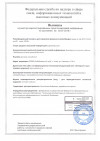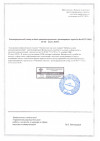УЧРЕДИТЕЛЬ: Федеральное государственное бюджетное образовательное учреждение высшего образования «Читинская государственная медицинская академия» Министерства здравоохранения Российской Федерации
РОЛЬ ИММУННЫХ КОНТРОЛЬНЫХ ТОЧЕК В ФОРМИРОВАНИИ ОПУХОЛЕВОЙ ИММУНОСУПРЕССИИ У БОЛЬНЫХ СО ЗЛОКАЧЕСТВЕННЫМИ НОВООБРАЗОВАНИЯМИ
Резюме
| Название статьи | РОЛЬ ИММУННЫХ КОНТРОЛЬНЫХ ТОЧЕК В ФОРМИРОВАНИИ ОПУХОЛЕВОЙ ИММУНОСУПРЕССИИ У БОЛЬНЫХ СО ЗЛОКАЧЕСТВЕННЫМИ НОВООБРАЗОВАНИЯМИ |
|---|---|
| Title | THE ROLE OF THE IMMUNE CONTROL POINTS IN THE GENERATION OF IMMUNOSUPPRESSION OF TUMOR IN PATIENTS WITH CANCER |
| Категория | номер 4 за 2023 год (опубликован 28.12.2023) |
| Тип | Обзорная статья |
| Ключевые слова | злокачественная опухоль, иммунные контрольные точки, канцерогенез, опухолевая иммуносупрессия |
| Keywords | cancer, immune control points, carcinogenesis, immunosuppression of tumor |
| Скачать | Скачать статью |
| doi | 10.52485/19986173_2023_4_77 |
| УДК | 616-006.04-092:612.017 |
| Резюме | В обзоре обобщены данные литературы о вкладе иммунных контрольных точек в развитие опухолевой иммуносупрессии у пациентов со злокачественными новообразованиями различных локализаций. Описана молекулярная характеристика иммунных контрольных точек, а также особое внимание уделено иммунотерапии рака, основанной на блокировании иммунных контрольных точек. |
| Список литературы | 1. Decker W. E. Cancer immunotherapy: historical perspective of a clinical revolution and emerging preclinical animal models. Frontiers in immunology. 2017. 8 (3). 829-835. |
| 2. Burnet M. Cancer: a biological approach. III. Viruses associated with neoplastic conditions. IV Practical applications. Br. Med. J. 1957. 1. 841-847. DOI: https://doi.org/ 10.1136/bmj.1.5023.841. | |
| 3. Thomas L. Cellular and Humoral Aspects of the Hypersensitive States. New York: Hober-Harper. 1959. 529-532. | |
| 4. Morales A. Intracavitary Bacillus Calmette-Guerin in the treatment of superficial bladder tumors. J Urol. 1976. 116. 180-183. DOI: https://doi.org/10.1016/S0022-5347. | |
| 5. Choi A.H. From benchtop to bedside: a review of oncolytic virotherapy. Biomedicines. 2016. 4. 18. DOI: https://doi.org/10.3390.40300018. | |
| 6. Krummel M.F. CD28 and CTLA-4 have opposing effects on the response of T cells to stimulation. J. Exp. Med. 1995. 182 (2). 459-465. DOI:https://doi.org/ 10.1084/jem.182.2.459. | |
| 7. Eptaminitaki G.C. Long Non-Coding RNAs (lncRNAs) in Response and Resistance to Cancer Immunosurveillance and Immunotherapy. Cells. 2021. 10 (12). 3313. DOI:https://doi.org/ 10.3390/ cells10123313. | |
| 8. Li F. Immune checkpoint inhibitors and cellular treatment for lymphoma immunotherapy. Clinical and Experimental Immunology. 2021. 205(1). 1-11. DOI:https://doi.org/10.1111/cei.13592. | |
| 9. Lopez S.H. The gut wall’s potential as a partner for precision oncology in immune checkpoint treatment. Cancer Treatment Reviews. 2022. 1. 102406. DOI:https://doi.org/10/1016/j.ctrv.2022.102406. | |
| 10. Ghorbaninezhad F. CTLA-4 silencing in dendritic cells loaded with colorectal cancer cell lysate improves autologous T cell responses in vitro. Front Immunol. 2022. 13. 931316. DOI: https://doi.org/10.3389/ fimmu.2022.931316. | |
| 11. Guo X.J. CTLA-4 Synergizes with PD1/PD-L1 in the Inhibitory Tumor Microenvironment of Intrahepatic Cholangiocarcinoma. // Front Immunol. 2021. 12. 705378. DOI:https://doi.org/10.3389/fimmu.2021.705378. | |
| 12. Borrie A.E. Lymphocyte-based cancer immunotherapeutics. Int. Rev. Cell. Mol. Biol. 2018. 341. 201-276. DOI: https://doi.org/10.1016/bs.ircmb.2018.05.010. | |
| 13. Cohen E.E.W. The Society for Immunotherapy of Cancer consensus statement on immunotherapy for the treatment of squamous cell carcinoma of the head and neck (HNSCC). Journal for immunotherapy of cancer. 2019. 7 (1). 1-31. DOI:https://doi.org/10.1186/s40425-019-0662-5. | |
| 14. Korman A.J. The foundations of immune checkpoint blockade and the ipilimumab approval decennial. Nature Reviews Drug Discovery. 2022. 21 (7). 509-528. DOI:https://doi.org/10.1038/s41573-021-00345-8. | |
| 15. Moschos S.J. Melanoma Brain Metastases: An Update on the Use of Immune Checkpoint Inhibitors and Molecularly Targeted Agents. Am J Clin Dermatol. 2022. 23 (4). 523-545. DOI: https://doi.org/10.1007/ s40257-022-00678-z. | |
| 16. Bagbudar S. Prognostic Implications of Immune Infiltrates in the Breast Cancer Microenvironment: The Role of Expressions of CTLA-4, PD-1, and LAG-3. Applied Immunohistochemistry & Molecular Morphology. 2022. 30 (2). 99-107. DOI:https://doi.org/10.1097/PAI.0000000000000978. | |
| 17. Lin H.J. Breast cancer tumor microenvironment and molecular aberrations hijack tumoricidal immunity. Cancers. 2022. 14 (2). 285. DOI:https://doi.org/ 10.3390/cancers14020285. | |
| 18. Rowshanravan B. CTLA-4: a moving target inimmunotherapy. Blood. 2018. 131(1). 58-67. DOI: https:// doi.org/10.1182/blood-2017-06-741033. | |
| 19. Li X. Liposomal Co-delivery of PD-L1 siRNA/Anemoside B4 for Enhanced Combinational Immunotherapeutic Effect. ACS Applied Materials & Interfaces. 2022. 14(25). 28439-28454. DOI: https:// doi.org/10.1021/acsami.2c01123. | |
| 20. Andrieu G.P. BET protein targeting suppresses the PD-1/PD-L1 pathway in triple-negative breast cancer and elicits anti-tumor immune response. Cancer letters. 2019. 465. 45-58. DOI: https://doi.org/10.1016/j. canlet.2019.08.013. | |
| 21. Doi T. The JAK/STAT pathway is involved in the upregulation of PD-L1 expression in pancreatic cancer cell lines. Oncol Rep. 2017. 37. 1545-1554. DOI:https://doi.org/ 10.3892/or.2017.5399. | |
| 22. Jalali S. Reverse signaling via PD-L1 supports malignant cell growth and survival in classical Hodgkin lymphoma. Blood Cancer J. 2019. 9 (22). DOI:https://doi.org/ 10.1038/s41408-019-0185-9. | |
| 23. Peng Q. Mitogen-activated protein kinase signaling pathway in oral cancer. Oncol Lett. 2018. 15. 1379- 1388. DOI: https://doi.org/10.3892/ol.2017.7491. | |
| 24. Stutvoet T.S. MAPK pathway activity plays a key role in PD-L1 expression of lung adenocarcinoma cells. J. Pathol. 2019. 249. 52-64. DOI: https://doi.org/10.1002/path.5280. | |
| 25. Zhang X. Clinical benefits of PD-1/PD-L1 inhibitors in patients with metastatic colorectal cancer: a systematic review and meta-analysis. World Journal of Surgical Oncology. 2022. 20 (1). 1-13. DOI: https:// doi.org/10.1186/s12957-022-02549-7. | |
| 26. Zeidan A.M. TIM-3 pathway dysregulation and targeting in cancer. Expert Review of Anticancer Therapy. 2021. 21 (5). 523-534. DOI:https://doi.org/ 10.1080/14737140.2021.1865814. | |
| 27. Li G. LncRNA DLEU2 is activated by STAT1 and induces gastric cancer development via targeting miR-23b-3p/NOTCH2 axis and Notch signaling pathway. Life Sci. 2021. 277. 119419. DOI: https://doi. org/10.1016/j.lfs.2021.119419. | |
| 28. Philip M. CD8+ T cell differentiation and dysfunction in cancer. Nature Reviews Immunology. 2022. 22(4). 209-223. DOI: https://doi.org/10.1038/s41577-021-00574-3. | |
| 29. Gowan C.C. The Combination of TIM3 - Based Checkpoint Blockade and Oncolytic Virotherapy Regresses Established Solid Tumors. Journal of Immunotherapy. 2023. 46 (1). 1-4. DOI: https://doi.org/10.1097/ CJI.0000000000000444. | |
| 30. Pagliano O. Tim-3 mediates T cell trogocytosis to limit antitumor immunity. The Journal of clinical investigation. 2022. 132 (9). e152864. DOI:10.3390/biomedicines10112826. | |
| 31. Curigliano G. Phase I/Ib Clinical Trial of Sabatolimab, an Anti-TIM-3 Antibody, Alone and in Combination with Spartalizumab, an Anti-PD-1 Antibody, in Advanced Solid Tumors. Clin Cancer Res. 2021. 27 (13). 3620-3629. DOI: https://doi.org/10.1158/1078-0432.CCR-20-4746. | |
| 32. Long L. The promising immune checkpoint LAG-3: from tumor microenvironment to cancer immunotherapy. Genes Cancer. 2018. 9 (6). 176-189. DOI:https://doi.org /10.18632/ genesandcancer.180. | |
| 33. Garrido F. The urgent need to recover MHC class I in cancers for effective immunotherapy. Curr Opin Immunol. 2016. 39. 44-51. DOI: https://doi.org/10.1016/j.coi.2015.12.007. | |
| 34. Guy C. LAG3 associates with TCR–CD3 complexes and suppresses signaling by driving co-receptor-Lck dissociation. Nature Immunology. 2022. 23 (5). 757-767. DOI:https://doi.org/10.1038/s41590-022-01176- 4. | |
| 35. Jonkman T.H. Functional genomics analysis identifies T and NK cell activation as a driver of epigenetic clock progression. Genome biology. 2022. 23 (1). 1-21. DOI: https://doi.org/10.1186/s13059-021-02585-8. | |
| 36. Rhyner Agocs G. LAG-3 Expression Predicts Outcome in Stage II Colon Cancer. Journal of personalized medicine. 2021. 11 (8).749. DOI: https://doi.org/10.3390/jpm11080749. | |
| 37. Stirling E.R. Metabolic Implications of Immune Checkpoint Proteins in Cancer. Cells. 2022. 11 (1). 179. DOI: https://doi.org/10.3390/cells11010179. | |
| 38. Upadhyaya P. Discovery and optimization of a synthetic class of Nectin-4-targeted CD137 agonists for immuno-oncology. 2022. 65 (14). 9858-9872. DOI: https://doi.org/ 10.1021/acs.jmedchem.2c00505. | |
| 39. Meier S.L. Bystander T-cells in cancer immunology and therapy. Nature Cancer. 2022. 3 (2). 143-155. DOI: https://doi.org/10.1038/s43018-022-00335-8. | |
| 40. Gardner T.A. Sipuleucel-T (Provenge) autologous vaccine approved for treatment of men with asymptomatic or minimally symptomatic castrate-resistant metastatic prostate cancer. Hum Vaccin Immunother. 2012. 8. 534-539. DOI: https://doi.org/10.4161/hv.19795. | |
| 41. Cheng H. Emerging targets of immunotherapy in gynecologic cancer. Onco Targets Ther. 2020. 13. 11869- 11882. DOI: https://doi.org/10.2147/OTT.S282530. | |
| 42. Wu J. Role of TNFSF9 bidirectional signal transduction in antitumor immunotherapy. European Journal of Pharmacology. 2022. 928. 175097. DOI: https://doi.org/10.1016./j.ejphar.2022.175097. | |
| Resume | The review summarizes literature data about role of immune control points to the development of immunosuppression in patients with cancer. The molecular characteristics of immune control points are described, and special attention is paid to the cancer immunotherapy based on blocking immune control points. |
| Автор 1 | Четверяков Андрей Валерьевич |
| Автор 2 | Крюкова Виктория Викторовна |
| Автор 3 | Цепелев Виктор Львович |



